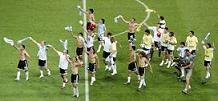Further Exploration of the 22 (4-3-1-2)
Return To Part.1
Also called 4-4-2 diamond, 4-3-1-2 is quite possibly the most balanced formation. With 5 defensive players and 5 attackers split into 2 semi-independant elements, 4-3-1-2 has the agility and elasticity few other formations could rival. Especially among balanced formations, 4-3-1-2 offers one of the best defensive setup while maintaining very significiant offensive presence. In 4-3-1-2, the CAM is highlighted at an unpresedented level. This CAM is specifically defined as an "Enganche". Enganche in spanish means "to hook" or "to link" .
In 4-3-1-2, the CAM is highlighted at an unpresedented level. This CAM is specifically defined as an "Enganche". Enganche in spanish means "to hook" or "to link" .
Linking is easy to understand, like a connection piece. But what is this hooking? It's the Tango move where the female dancer wraps her leg around the male dancer's body.
If lines are drawn between the CAM and the 4 other offensive players (2 forwards and 2 outside midfielders), they would all be free to pivot around the CAM. Therefore the the Enganche could also be considered a pivot point. Any 2 of these lines pivoting around the enganche then form an angle, so if you connect the 2 players at outter ends of these 2 lines, you have a triangle.
The idea of deploying an enganche is so the 4 offensive players can form many triangles with the CAM, so some routes to move the ball forward would always exist while having the space around the ball under controll.
In order to do this, the 4 players must have a good understanding of their positions in relations with the enganche at all time, so when the enganche reposition himself, these players would know where to go and in what orientation and shape to form these 'triangles'.
One benefit of this cooperation between the offensive players and the enganche is that the connection piece function of the enganche gives extra lateral supports to the offensive players so they can have more lateral freedom and be allowed to position themselves more vertically inline in references to each other.
The lateral freedom allow these players to do alot of diagonal channeling, making them absolutely nightmare for opponents to mark. However, in order to maintain the uniformity of the entire offensive element, they also need to maintain their relationships with the enganche. So the lateral freedom isn't unrestricted, and vertically they must stay at the correct level compared to each other.
Usually one of the outside midfielders need to be more defensive than the other. When the forward element/sub-formation operates, he would usually stay at a relatively lower position than the other outside midfielder. So this midfielder also serves the purpose of a semi-defensive midfielder. Vise versa, the other outside midfielder would be more like an attacking mid.
The enganche must then drag this 'planetary system like' sub-formation around the field by relocating himself (both vertically and horizontally). By doing so, not only was he able to concentrate the players around the bal area, also allowing them to be in good positions for their defensive duties.
While the enganche, the 2 outside midfielders and the 2 forwards work as an integrated and semi-independant offensive element, the rest of the field work as the also semi-independant defensive element. With 4 players forming a tightly spaced backline and a holding midfielder screening infront of it.
Due to the relatively free displacements of the offensive players (especially the enganche and the 2 outside midfielders), the backline need to push forward constantly so the defensive and the offensive elements stay at ideal distance from each other. Then on top of that, one of the fullbacks usually would be choosen from the wingback pool so he could sprint up and add even more complexity to the offense.
4-3-1-2 is a 5:5 formation where at least one of the 5 defensive players (wingback) usually also shoulder some offensive responsibilities. So it requires an excellent holding midfielder to ensure overal quality of the defense. In Argentina's case, Mascherano. Mascherano is stronger than Gago defensively. With 4-3-1-2 the holding midfielder's defensive duties overweights the need to initiate attacks, therefore Mascherano would be more reliable to fill the CDM position than Gago.
The defense player pool of this Copa America team only allow the right side to have wingback function so ideal D-line would be Zanetti, Ayala, Milito and Heinze.
In the midfield, Roman's return indicates that he's the best enganche in Basile's opinion. So first choice CAM would be Riquelme. Aimar can be super sub so if Riquelme failed to perform we would still be able to use 4-3-1-2. Defensive to offensive order of the other midfielders should go like: Cambiasso -> Veron -> Aimar -> Lucho -> Messi. So depend on the team we're against. Against more offensive teams we should use a combination of Cambiasso with Veron/Aimar/Lucho; Against defensive teams we could use Veron in combination with Lucho Aimar or even Messi; Lucho and Aimar or Lucho and Messi would be a even more offensive option, which we probably won't see in this tournement.
Also worth to note, since Lucho has right preference, when Lucho is on the field, the other outside midfielder should start on the left, just a general rule when drawing the formation charts, eventhough the lateral differences of the 2 outside midfielders' starting positions in 4-3-1-2 has minimum impacts, as illustrated in this diagram.
And in the front, one forward needs to be the general target person so one of the taller guys should be used. Crespo starting wouldn't be a surprise. The other forward will be chosen between Messi, Tevez and Palacio. If both Crespo and Messi perform well, Tevez, Palacio and Milito might only start for fatigue or injury reasons.
Once the importance of Enganche was understood, scientific guesses can be made in attempt to understand the recent events, namely Veron and Roman's return, and now benching of Cambiasso to yield room for Aimar.
First of all, why Riquelme?
Because Roman is the best enganche in the world!
He had always been Basile's choice, it was determined long ago, just not announced for obvious reasons.
But Roman has the potential to tank games. We know how important enganche is to the 4-3-1-2 formation. If Roman isn't performing, subbing him out would become a priority.
Secondary enganche is Aimar. If Roman sucked, and if at this time Aimar wasn't on the field, then Basile must use a sub to bring on Aimar and replace Roman, which might not of been an option in real matches (used up subs for example).
So a safer option would be starting Aimar on the field at a position other than CAM. In which case if Riquelme started to tank, he could switch positions with Aimar. Roman would still be able to function as left outside midfielder, and enganche would be replaced by a less talented by more consistant Aimar.
But then you face the problem of having Aimar on the wing, which isn't his best position, and there are other Argentine player(s) better suited to the position. This safer option isn't without compromises.
Whether Basile need to employ the safer option depend largely on how the team would function without a proper enganche. If they do ok, then Aimar starting at a wing wouldn't be necessary. If the other way around, then Aimar better start or it would be too risky for tournement matches, especially at knockout stages.
Therefore, Basile's priority in the friendlies would be to test the team with a "not functioning" enganche. This 'not functioning' enganche was played by Messi.
Messi doesn't have the experience to play enganche, and possibly doesn't know how. Enganche role isn't something any good player can play, it takes alot of indepth studies of related tactics and strategies, which isn't something Messi could of done in just a few days.
In the friendlies, the team played ok with the 'not functioning' enganche. but not excellent since Basile subbed in Aimar in both games after all. Something went wrong so he had to put in a real enganche to prevent a lose (possibly to gain a win in second friendly for moral purposes).
Eventhough Aimar had to jump in, apparently these 'ok performances' were good enough for Basile to go for a real outside midfielder, and his choice was Veron.
Basile probably had Veron in mind all along, just needed the chances (friendlies) to make sure he could play Veron (and bench Aimar).
Now, Aimar taking over from Cambiasso issue.
It may well be what the press claimed, that Aimar was performing well and worthy of one of the outside midfelder spots.
But if following the above trend of critical analyzation, this could also indicate that Basile didn't like what he saw in Riquelme over the practices. If such assumption stand correct, then using Veron over Cambiasso could of meant that Basile wanted to preserve more offensive capabilities by sacrificing some defense. It's the US we're playing in first game anyway, not expected to be a particularly tough match.
Return to Part.1
4-3-3
4-2-3-1
To Conclusion





4 comments:
I am simply amazed with your explorations into all these different formations and their suitability for the albicelestes. I see you are an engineer. no surprise, that you have brought your understanding of angles and movements into this anyalysis of formations. At the same time, you have not lost track of the fact that this game is an art - we play and follow this game for its ebbs and flows and its appeal to our emotions. Just awesome.
Long live attacking football!!!
First comment on the blog, thank you :D A positive comment on top of that, i'm truely flattered.
Negative comments are more than welcome too, so I could learn through mistakes, and take the trials and erors approach to better this blog.
Brilliant peice , very well analysed..I am very interested in discussing more about different syles and tactics.. I take a keen interest in the different subtleties of football, the different formations , styles etc etc. It would be great to discuss it with some one who knows his stuff!.
Nice piece. Love the 4 3 1 2 formation!
Post a Comment